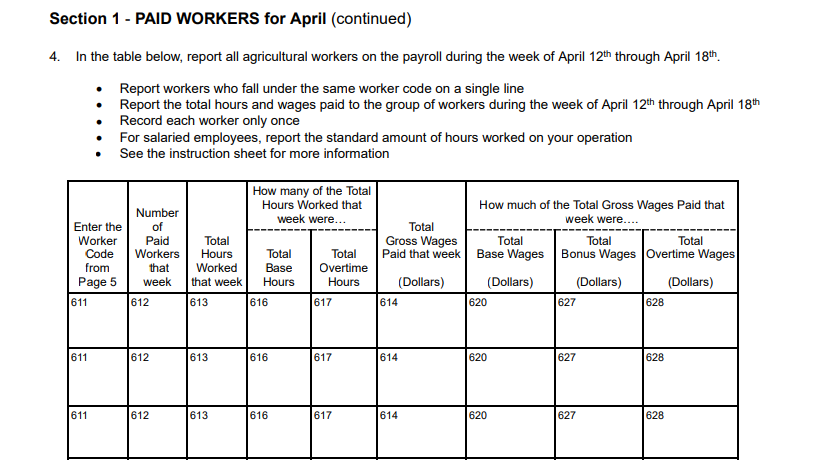Supplemental Supporting Statement Part A for Substantive Changes July 2021
0109-labor-2021-SSA - Rev 7-23-2021.docx
Agricultural Labor
Supplemental Supporting Statement Part A for Substantive Changes July 2021
OMB: 0535-0109
1Supporting Statement
AGRICULTURAL LABOR SURVEY
OMB No. 0535-0109
TERMS OF CLEARANCE: Terms of the previous clearance remain in effect. Because this reinstated data collection will now cover a reference period of approximately two months in retrospect and the fact that targeted respondents will now be otherwise employed in the agricultural cycle which will affect their availability, NASS should assess any bias due to non-response along with overall quality deficiencies of the data that could lead to inconsistent data from this collection being reported in the farm labor series. The agency should report to OMB their findings before publishing the collected data. This additional analysis should also be included in the report disseminating the results of the data collection.
NASS RESPONSE: On February 3, 2021, NASS provided the required information to OMB and on February 11, 2021 NASS included the required information in the Farm Labor publication.
A. JUSTIFICATION
This is a request to make a substantive change to the currently approved docket.
In this substantive change, NASS will reduce the sample size and reduce the number of questions being asked. Previously, NASS conducted the Agricultural Labor Survey under a cooperative agreement with the US Department of Labor (DOL). Recently, the DOL cut off funding of the Labor survey, warranting this reduction in sample size and cut in the number of questions asked. NASS will publish the results of the survey, but the publication will resemble the publication that was published on Nov. 15, 2018. The questions that will be removed from the questionnaire are those referencing base wages, base hours worked, overtime wages, overtime hours worked, and bonus wages. NASS will still collect gross wages and total hours worked.
1. Explain the circumstances that make the collection of information necessary. Identify any legal or administrative requirements that necessitate the collection. Attach a copy of the appropriate section of each statute and regulation mandating or authorizing the collection of information.
Agricultural labor statistics are an integral part of the primary function of the National Agricultural Statistics Service (NASS), which is the collection, processing, and dissemination of current State, regional, and national agricultural statistics. Wage rate estimates have been published since 1866 and U.S. farm employment estimates have been published since 1910. General authority for these data collection activities are granted under U.S. Code Title 7, Section 2204 which specifies that "The Secretary of Agriculture shall procure and preserve all information concerning agriculture which he can obtain ... by the collection of statistics ... and shall distribute them among agriculturists."
According to data from the 2017 Census of Agriculture, wages and salaries plus contract labor costs represented just 12 percent of production expenses for all farms, but 43 percent for greenhouse and nursery operations and 39 percent for fruit and tree nut operations.
This substantive change would be for the October 2021 Labor survey due to the reduction in funding. The changes to our current approval are summarized as:
Remove from the questionnaire questions regarding:
Base hours worked and wages,
Overtime hours worked and wages, and
Bonus wages.
No longer publish:
Estimates for Standard Occupational Code (SOC) by region (national-level gross wage rates by SOC estimates will continue).
Base or overtime hours and wages for any geographic area (i.e., national or regional).
The sample size will be reduced because regional SOC estimates will not be published.
NASS will continue to:
Collect data on gross hours worked and wages,
Publish quarterly gross wage rates and hours by SOC at the national level,
Publish quarterly and annual gross wage rates and hours at the Agricultural Labor Region level.
2. Indicate how, by whom, and for what purpose the information is to be used. Except for a new collection, indicate the actual use the agency has made of the information received from the current collection.
The Agriculture Adjustment Act of 1938, as amended, requires USDA to compute parity prices of farm products. This computation uses an index of prices paid by farmers which in turn is composed of five indexes, one of which is an index of wage rates. Wage rate estimates are the most widely used component of the Agricultural Labor Survey program. These estimates measure actual agricultural wage rates as well as year-to-year changes.
Under the H-2A program for agriculture, part of the Immigration Reform and Control Act of 1986, agricultural employers are permitted to employ foreign workers only if domestic workers are unavailable and the employment of foreign workers will not adversely affect wages and working conditions of U.S. agricultural workers employed in similar work. The Agricultural Labor Survey program is a critical source in determining the number of domestic workers who apply for work and ensuring that foreign workers cause no adverse effect on American farm workers. The minimum wage rate offered by agricultural employers as a requirement for employing foreign workers is determined by Federal regulations (CFR 655.107 Adverse Effect Wage Rates).
Data on number of workers and hours worked are used to estimate agricultural productivity. The Employment Standards Administration in the Department of Labor uses estimates of agricultural workers in conjunction with their estimates of employment covered by the Fair Labor Standard Act of 1938, as amended.
The data will still be collected for the following Standard Occupational Classifications:
Agricultural workers are estimated in four categories--field workers, livestock workers, field and livestock workers combined, and all hired workers (including supervisors and other workers) to provide a basis for meaningful comparison with the nonagricultural sector and to determine the impact of changes in the level of the Federal minimum wage.
The Bureau of Economic Analysis (BEA) in the Department of Commerce relies on the number of hired agricultural workers, hours worked, and wages paid as components in personal and national income for the agricultural sector of the gross domestic product (GDP). Legislatures and policy makers use agricultural labor data when setting policy that affects the farm sector. According to the USDA’s Economic Research Service (ERS) - Agriculture, food, and related industries contributed $1.109 trillion to the U.S. gross domestic product (GDP) in 2019, a 5.2-percent share. The output of America’s farms contributed $136.1 billion of this sum—about 0.6 percent of GDP.
Agricultural Labor Survey employment data (for example, worker numbers and wage rates) are used to ensure equitable allocation of federal assistance for farm workers. This includes support for housing and education for seasonal farm workers.
Changes in wage rates help measure the changes in costs of production of major farm commodities. Cost of production estimates are used by policy makers to help determine support levels for farm programs, including target prices, loan rates, and the milk support price. Price supports affect all farmers directly or indirectly. Price supports for grain farmers, for example, are generally used to ensure grain supplies are adequate and grain prices for livestock producers are reasonable.
The Agricultural Labor Survey provides data that can be used to measure the availability of farm workers across the nation, and be used to help determine if there is a shortage of farm laborers.
Labor data are used by policy makers in determining immigration policies. Analysts use the data to evaluate the effects of changes in the immigration and labor laws on producers, wage rates, and costs of production.
Agricultural labor data are used by farm worker organizations to help set wage rates and negotiate labor contracts as well as to determine the need for additional workers. They are also used by private organizations and government agencies responsible for the planning and placement of farm workers and those that work closely with employer and labor crew chiefs.
The Economic Research Service in USDA also uses wage rate data to estimate labor costs for crop and livestock enterprise budgets.
The following two tables show the changes made to the questionnaires.
New Format
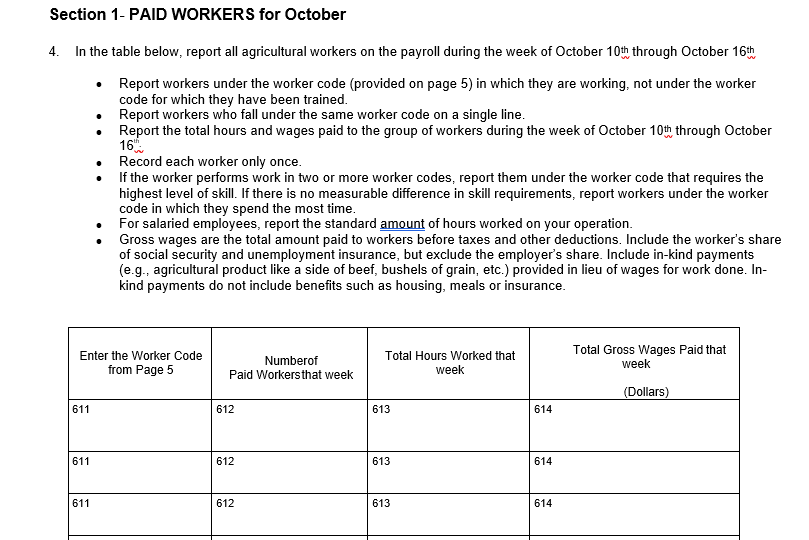
Previous Format
|
NASS plans to continue to publish the data for the 4 worker categories, to maintain the historic data series.
From the tables that were published in the February 11, 2021 Farm Labor publication, the following tables will be removed from future publications.

3. Describe whether, and to what extent, the collection of information involves the use of automated, electronic, mechanical, or other technological collection techniques or other forms of information technology, e.g., permitting electronic submission of responses, and the basis for the decision for adopting this means of collection. Also describe any consideration of using information technology to reduce burden.
Web-based data reporting is available for these surveys. The percent of operators who responded by internet in April 2021 was 5.3%. In Item 12 below additional burden and responses were added to the burden table to allow for the possible use of a push postcard to encourage the use of internet responses.
4. Describe efforts to identify duplication. Show specifically why any similar information already available cannot be used or modified for use for the purposes described in Item 2 above.
The National Agricultural Statistics Service cooperates with State departments of agriculture and land grant universities to conduct agricultural surveys. These surveys meet both State and Federal needs, thus eliminating duplication and minimizing reporting burden on the agricultural industry. For example, NASS has worked jointly with the California Employment Development Department (EDD) since January 1997 to use one labor questionnaire for both organizations. This administrative data provided to NASS by EDD eliminates the need for operators to report similar data to two government agencies. Respondent burden is reduced by collecting data for both the State of California and USDA during only one data collection effort.
The Agricultural Labor Survey is the only timely and reliable source of information on the size of the farm worker population. The data collected on this survey are not available from any other source.
5. If the collection of information impacts small businesses or other small entities (Item 5 of OMB Form 83-I), describe any methods used to minimize burden.
Information requested for agricultural labor can be provided with a minimum of difficulty by the respondent. Farms using a small number of workers generally provide the needed data without having to consult their record books, while large labor users can respond by using their normal day-to-day operating records.
6. Describe the consequence to Federal program or policy activities if the collection is not conducted or is conducted less frequently, as well as any technical or legal obstacles to reducing burden.
Prior to 2013 NASS conducted the Agricultural Labor Survey on a quarterly basis and published the results quarterly. In 2013 NASS began collecting quarterly farm labor data by contacting respondents only twice a year. The April survey collects data for the January and April reference periods. The October survey collects data for the July and October reference periods. This was done in order to cut data collection costs. Although quarterly data was being published it was only made available twice a year (following each biannual survey). Data is published in May and November.
7. Explain any special circumstances that would cause an information collection to be conducted in a manner inconsistent with the general information guidelines in 5 CFR 1320.5.
There are no special circumstances. The collection of information is conducted in a manner consistent with the guidelines in 5 CFR 1320.6.
8. Provide a copy and identify the date and page number of publication in the Federal Register of the agency's notice, required by 5 CFR 1320.8 (d), soliciting comments on the information collection prior to submission to OMB. Summarize public comments received in response to that notice and describe actions taken by the agency in response to these comments.
The original notice soliciting comments on this collection was published in the Federal Register on October 6, 2017 on page 46753. The notice announced the intent to renew the data collection project for 3 years. NASS received only one public comment; Farm Worker Justice (a national advocacy organization) is in support of the continuation of the Agricultural Labor survey. Their comments and NASS’s response are both included as attachments to this renewal.
Describe efforts to consult with persons outside the agency to obtain their views on the availability of data, frequency of collection, the clarity of instructions and record-keeping, disclosure, or reporting format (if any), and on the data elements to be recorded, disclosed, or reported.
NASS stays in close contact with Department-level personnel involved with agricultural labor policy. In addition, each year NASS conducts a series of meetings at various sites across the United States to maintain a dialogue with farmers and industry leaders to discuss issues relevant to NASS programs. Agricultural labor is one of the areas highlighted in these meetings. Consultations with the Department of Labor, the Economic Research Service, and the Bureau of Economic Analysis are ongoing.
9. Explain any decision to provide any payment or gift to respondents.
There are no payments or gifts to respondents.
10. Describe any assurance of confidentiality provided to respondents and the basis for the assurance in statute, regulation, or agency policy.
Questionnaires include a statement that individual reports are confidential. U.S. Code Title 18, Section 1905; U.S. Code Title 7, Section 2276; and Title III of Pub. L. No. 115-435 (CIPSEA) provide for confidentiality of reported information. All employees of NASS and all enumerators hired and supervised under a cooperative agreement with the National Association of State Departments of Agriculture (NASDA) must read the regulations and sign a statement of compliance.
Additionally, NASS employees and NASS contractors comply with the OMB implementation guidance document, “Implementation Guidance for Confidential Information Protection and Statistical Efficiency Act of 2018, Title III of Pub. L. No. 115-435, codified in 44 U.S.C. Ch. 35” CIPSEA supports NASS’s pledge of confidentiality to all respondents and facilitates the agency’s efforts to reduce burden by supporting statistical activities of collaborative agencies through designation of NASS agents, subject to the limitations and penalties described in CIPSEA.
The following confidentiality pledge statement will appear on all NASS questionnaires.
The information you provide will be used for statistical purposes only. Your responses will be kept confidential and any person who willfully discloses ANY identifiable information about you or your operation is subject to a jail term, a fine, or both. This survey is conducted in accordance with the Confidential Information Protection and Statistical Efficiency Act of 2018, Title III of Pub. L. No. 115-435, codified in 44 U.S.C. Ch. 35 and other applicable Federal laws. For more information on how we protect your information please visit: https://www.nass.usda.gov/confidentiality. Response to this survey is voluntary.
11. Provide additional justification for any questions of a sensitive nature.
There are no questions of a sensitive nature.
12. Provide estimates of the hour burden of the collection of information. The statement should indicate the number of respondents, frequency of response, annual hour burden, and an explanation of how the burden was estimated. If this request for approval covers more than one form, provide separate hour burden estimates for each form and aggregate the hour burdens in Item 13 of OMB Form 83-I. Provide estimates of annualized cost to respondents for the hour burdens for collections of information, identifying and using appropriate wage rate categories.
Burden hour calculations are shown below. The minutes-per-response figures come from telephone and field enumerator experience with previous labor surveys.
Cost to the public of completing the questionnaire is assumed to be comparable to the hourly rate of those requesting the data. Reporting time of 20,168 hours is multiplied by $36.97 per hour for a total cost to the public of $745,610.96.
NASS uses the Bureau of Labor Statistics’ Occupational Employment Statistics (most recently published on March 31, 2021 for the previous May) to estimate an hourly wage for the burden cost. The May 2020 mean wage for bookkeepers was $21.20. The mean wage for farm managers was $36.93. The mean wage for farm supervisors was $25.25. The mean wage of the three is $27.79. To calculate the fully loaded wage rate (includes allowances for Social Security, insurance, etc.) NASS will add 33% for a total of $36.97 per hour.
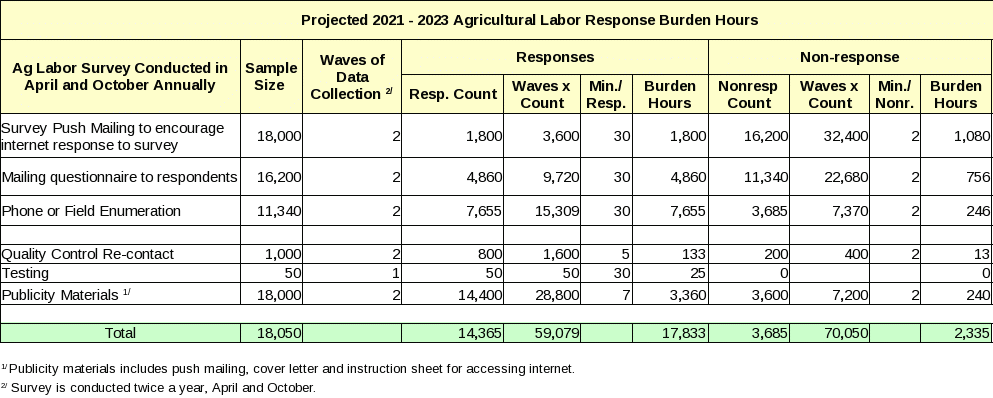
13. Provide an estimate of the total annual cost burden to respondents or record-keepers resulting from the collection of information.
There are no capital/start-up or ongoing operation/maintenance costs associated with this information collection.
14. Provide estimates of annualized cost to the Federal government; provide a description of the method used to estimate cost which should include quantification of hours, operational expenses, and any other expense that would not have been incurred without this collection of information.
The total cost to the Federal government for the agricultural labor survey for Fiscal Year 2022 is an estimated $2 million.
15. Explain the reasons for any program changes or adjustments reported in Items 13 or 14 of the OMB Form 83-I (reasons for changes in burden).
This is a revision of a currently approved information collection. The majority of the decrease in the number of responses and burden hours is due to a change in the sample sizes. A reduction in funding from the DOL caused the sample size to be reduced significantly. The increase in number of attempted responses and burden for ICR 2 is due to the addition of a potential mailing of a pre-survey post card to encourage internet responses.
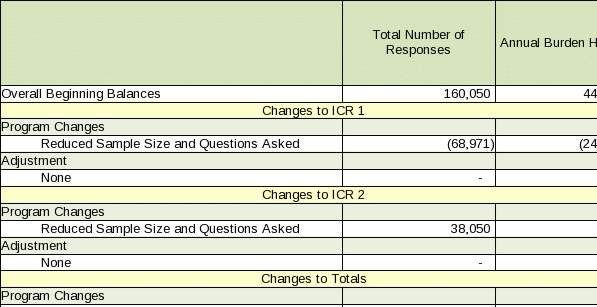
16. For collections of information whose results will be published, outline plans for tabulation and publication. Address any complex analytical techniques that will be used. Provide the time schedule for the entire project, including beginning and ending dates of the collection of information, completion of report, publication dates, and other actions.
Agricultural labor survey data collection procedures include periodic national training schools for statisticians and regular training sessions for enumerators conducted by NASS field offices.
Quarterly data are collected during the 2-week period following the survey reference week, which is the Sunday through Saturday period containing the 12th day of the survey months (January, April, July and October). This is the same week specified by other government agencies which deal with employment and wage series. Attached to this supporting statement is a sample questionnaire. The quality control sheet is also attached. Estimates are published approximately 30 days after the survey reference date. All agricultural labor releases can be found on the Web at:
https://usda.library.cornell.edu/concern/publications/x920fw89s
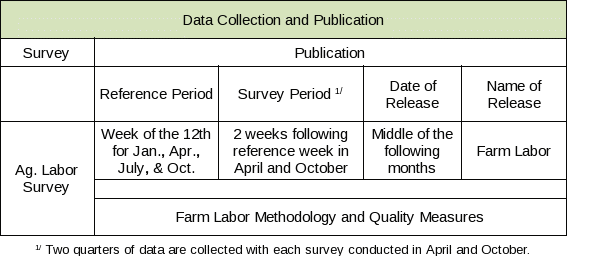
NASS quality measures and methodology reports can be found at the following link:
https://www.nass.usda.gov/Publications/Methodology_and_Data_Quality/Farm_Labor/05_2021/fmlaqm21.pdf
17. If seeking approval to not display the expiration date for OMB approval of the information collection, explain the reasons that display would be inappropriate.
There is no request for approval of non-display of the expiration date.
18. Explain each exception to the certification statement identified in Item 19, “Certification for Paperwork Reduction Act Submissions” of OMB Form 83-I.
There are no exceptions to the certification statement.
July 2021
| File Type | application/vnd.openxmlformats-officedocument.wordprocessingml.document |
| Author | HancDa |
| File Modified | 0000-00-00 |
| File Created | 2022-05-12 |
© 2025 OMB.report | Privacy Policy
